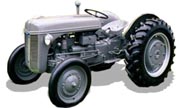jeff9366
Super Star Member
- Joined
- Jan 14, 2011
- Messages
- 12,787
- Tractor
- Kubota Tractor Loader L3560 HST+ ~~~~~~~~~~~~~ 3,700 pounds bare tractor, 5,400 pounds operating weight, 37 horsepower
The compact tractor era functionally began when Henry Ford licensed Harry Ferguson's tractor and Three Point Hitch design in 1939. The tractor industry uniformly adopted the Three Point Hitch after 1955, when Ferguson's patents began to expire and his tractor and Three Point Hitch design were available to industry participants besides Ford open source.
I would like input on the changes and any historical/implementation timing information known.
I'll start:
Improvements in approximate order: Power Steering, "live" then "independent" PTOs, Rollover Protection = ROPS, 4-WD, Industrial Tires, Loaders, later Loaders and attachments with SSQA, synchromesh geared transmissions, Diesel Engines, heavier tractors with Category 2-3-4-5 TPH, TPH telescoping Lower Links + pin-adjustable Lower Link stabilizers, Landscaping tractors of <2,000 pounds bare tractor weight, hydrostatic transmissions, shuttle shift gear transmissions, cruise control, Cabs with heat and AC. And, continuously, shields separating operator from moving parts.
I would like input on the changes and any historical/implementation timing information known.
I'll start:
Improvements in approximate order: Power Steering, "live" then "independent" PTOs, Rollover Protection = ROPS, 4-WD, Industrial Tires, Loaders, later Loaders and attachments with SSQA, synchromesh geared transmissions, Diesel Engines, heavier tractors with Category 2-3-4-5 TPH, TPH telescoping Lower Links + pin-adjustable Lower Link stabilizers, Landscaping tractors of <2,000 pounds bare tractor weight, hydrostatic transmissions, shuttle shift gear transmissions, cruise control, Cabs with heat and AC. And, continuously, shields separating operator from moving parts.
Last edited:


